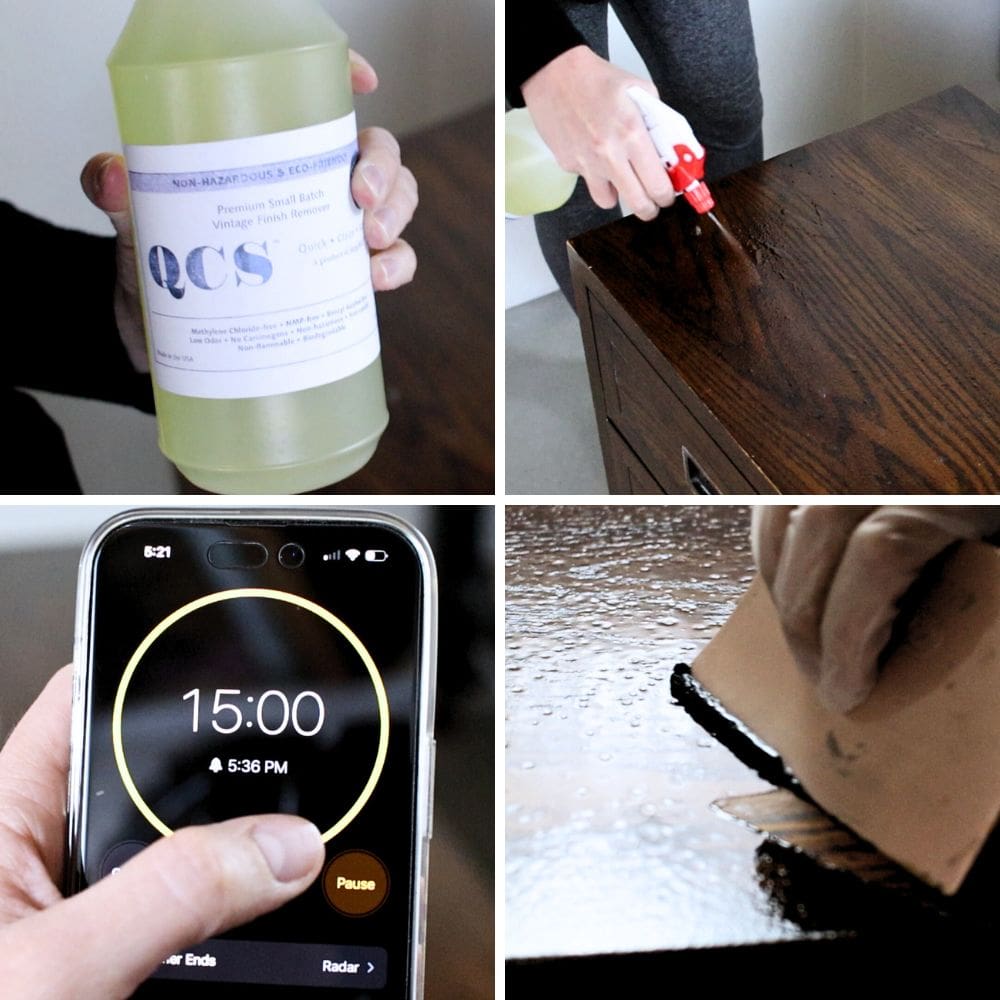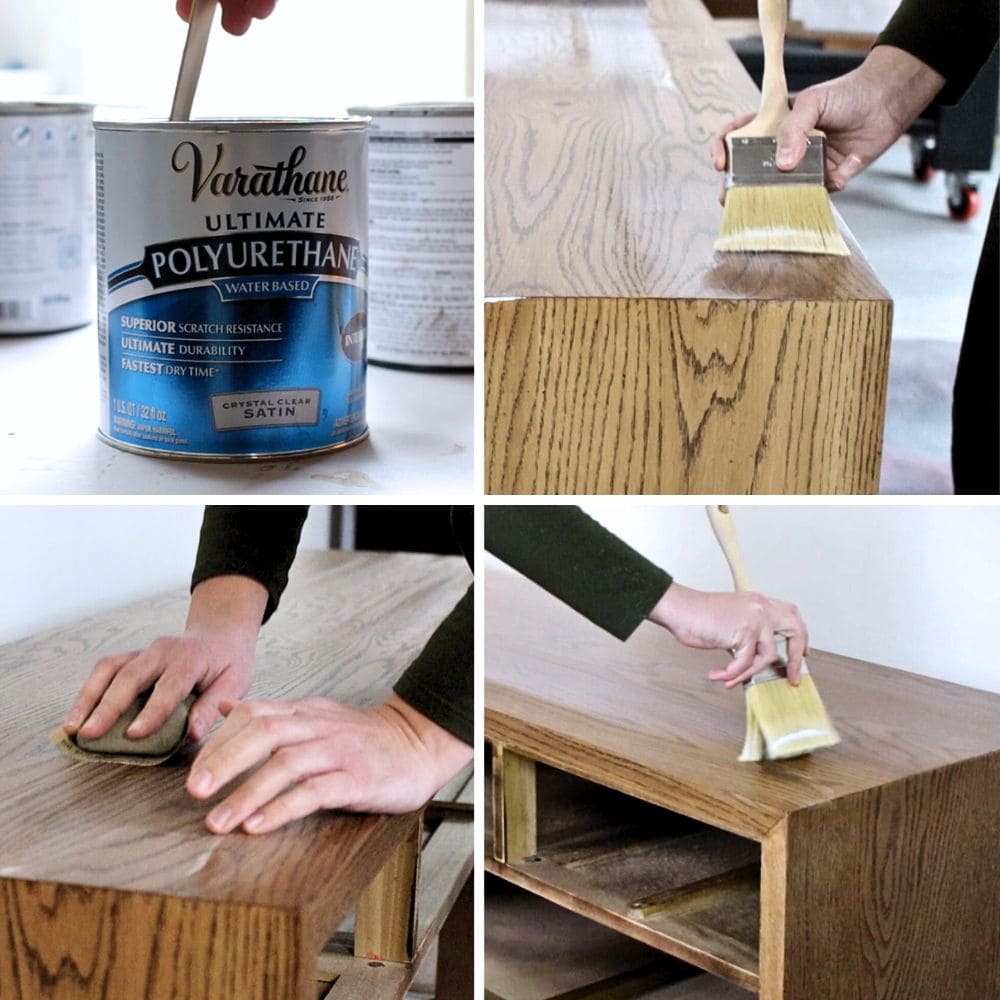Can You Sand Veneer and Stain It
If you have veneer furniture that’s seen better days, you may be wondering how to give it a refresh. But first, the question is: can you sand veneer and stain it? Veneer can be delicate and requires special care when it comes to refinishing furniture.
So let’s find out if you can sand and stain your veneer furniture, and if so, how to do it properly!

Veneer furniture has been around for a while and is popular due to its affordable price and attractive appearance. However, over time, it can become worn and damaged due to everyday use. Refinishing your furniture is a great way to restore its beauty and extend its lifespan.
But again, can you be able to sand and stain veneer furniture without causing damage to the delicate surface? First, let’s tackle what veneer exactly is!
What is Veneer?
Veneer is material made by slicing thin layers of real wood and applying them to a base wood such as MDF, particle board, or even hardwood. This gives the appearance of a solid and high end wood piece without the high cost. Veneer is commonly used in furniture, cabinetry, and flooring.
What Does Veneer Look Like
So how do you find out if your furniture has veneer? Look closely at the edges of the piece – if you see a thin dark line, that’s most likely the edge of the veneer. However, sometimes it can be well hidden and hard to spot.

Another way to determine if your furniture is veneered is to look at the grain pattern. Veneer typically has a consistent grain pattern that repeats itself, whereas solid wood will have natural variations in the grain.
Additionally, you may be able to feel the difference in texture between veneer and solid wood with your hand. Veneer tends to have a smoother and more uniform surface, while solid wood may feel rougher or have knots and imperfections.
Can You Sand and Stain Veneer?
So now that you know what veneer is and what it looks like, let’s get back to the questions at hand: can veneer be sanded? And can veneer be stained?
The answer is yes, you can do both! Sanding veneer allows you to remove the top layer and reveal a fresh surface, and staining veneer gives you the opportunity to change its color and enhance its appearance.

But if you have laminate veneer, then the answer is no – sanding and staining will not work on it. It’s important to know the difference between laminate and wood veneer before attempting any refinishing work.
While generally speaking, sanding and staining veneer can be done, it’s important to keep in mind that this requires special attention and care. As mentioned earlier, veneer is delicate and can easily be damaged if not handled properly.
How to Sand Veneer
So let’s learn how to sand veneer properly! If you choose to use a power sander, it’s important to be extra cautious. Using a coarse grit sandpaper like 80 or 100 grit with your sander can easily damage the finish on the veneer and quickly sand through the thin layer of wood.
So we prefer and recommend you use a chemical stripper like Stripwell QCS (use code SUNLIGHT10 to get 10% off your order of Stripwell QCS!) or Citristrip to remove the old finish before sanding it smooth.
These are 2 of the best wood stain removers on the market and what we have personally used and tested!

This way, you can prevent accidental damage to the veneer and guarantee a cleaner removal of the old finish. You can check out our post on how to strip paint from wood furniture to learn more about this process.
After stripping the finish on your veneer furniture, use a higher grit sandpaper to slowly and carefully sand the surface. It’s important to take your time to avoid sanding through the veneer.

If you do happen to sand through, it can be difficult to get a good stain finish, but with some additional products and techniques, you can still have a decent result. Sanded through veneer to particle board? Check out our post to learn a workaround!
So take your time and be gentle when sanding veneer! Overall, the key is to go slow and use caution to preserve the delicate surface and proceed to staining.
How to Stain Veneer
To begin staining your veneer furniture, make sure to tape off any areas that you don’t want to be stained. This will help create clean lines and prevent any unwanted color transfer onto other parts of the furniture.
Get your stain of choice and stir it gently until it reaches a uniform consistency. It’s always best to test the stain on a small, inconspicuous area of the veneer furniture so you can see the color and finish before proceeding with the entire piece.
Once you’re satisfied with the color, begin applying the stain with a brush or cloth, following the direction of the wood grain. For veneer, it’s important to use smooth and even strokes to avoid any streaks or uneven spots in the finish.

After you’ve applied the first coat of stain, let it sit for around 5-10 minutes depending on the product’s recommended time. This will allow the stain to penetrate and create a richer color.
Next, using a clean cloth, gently wipe off any excess stain from the surface. Be sure to still follow the direction of the wood grain to blend in any streaks or marks. Let the first coat dry completely before deciding if you want to apply a second coat for a deeper color.
Remember, it’s always better to start with less stain and build up to your desired color rather than applying too much at once. Once you’re satisfied with the color, it’s time to seal and protect your veneer furniture. Use the topcoat for painting furniture that is best for your needs and budget.
Polyurethane, wax, and polycrylic are popular options that provide durability and protection while enhancing the appearance of stained wood.
When applying a sealant, do a thin layer with long, smooth strokes following the direction of the wood grain. Sanding in between coats is optional but can help create a smoother and more professional finish.

Here’s sealing painted veneer furniture to learn more about the different types of sealants that you can use and how to choose the right one for your project.
Once your sealant is dry, your veneer furniture will now have a beautiful, long-lasting stain. Our post on how to stain wood furniture tackles this process in more detail so you can check it out and follow along. If you’re curious about painting veneer furniture, our guide will also be helpful!
So, to answer the question of whether you can sand and stain veneer – yes, you can! Veneer furniture can be sanded and stained with proper care and technique.
When sanding veneer, use caution and take your time to avoid damaging the delicate material. And when staining veneer, always test on a small area first then apply in smooth, even strokes following the direction of the wood grain.
More Refinishing Furniture Tips
- How to Repair (and Stain) Chipped Veneer Furniture
- Remove Stain From Wood Without Sanding
- How to Remove Veneer
- Sanded Through Veneer to Particle Board
- Easy Way to Sand Spindles
Follow us on YouTube to get more tips for painting furniture.
Or share your project with us on our Facebook Group and be part of our community. See you there!
